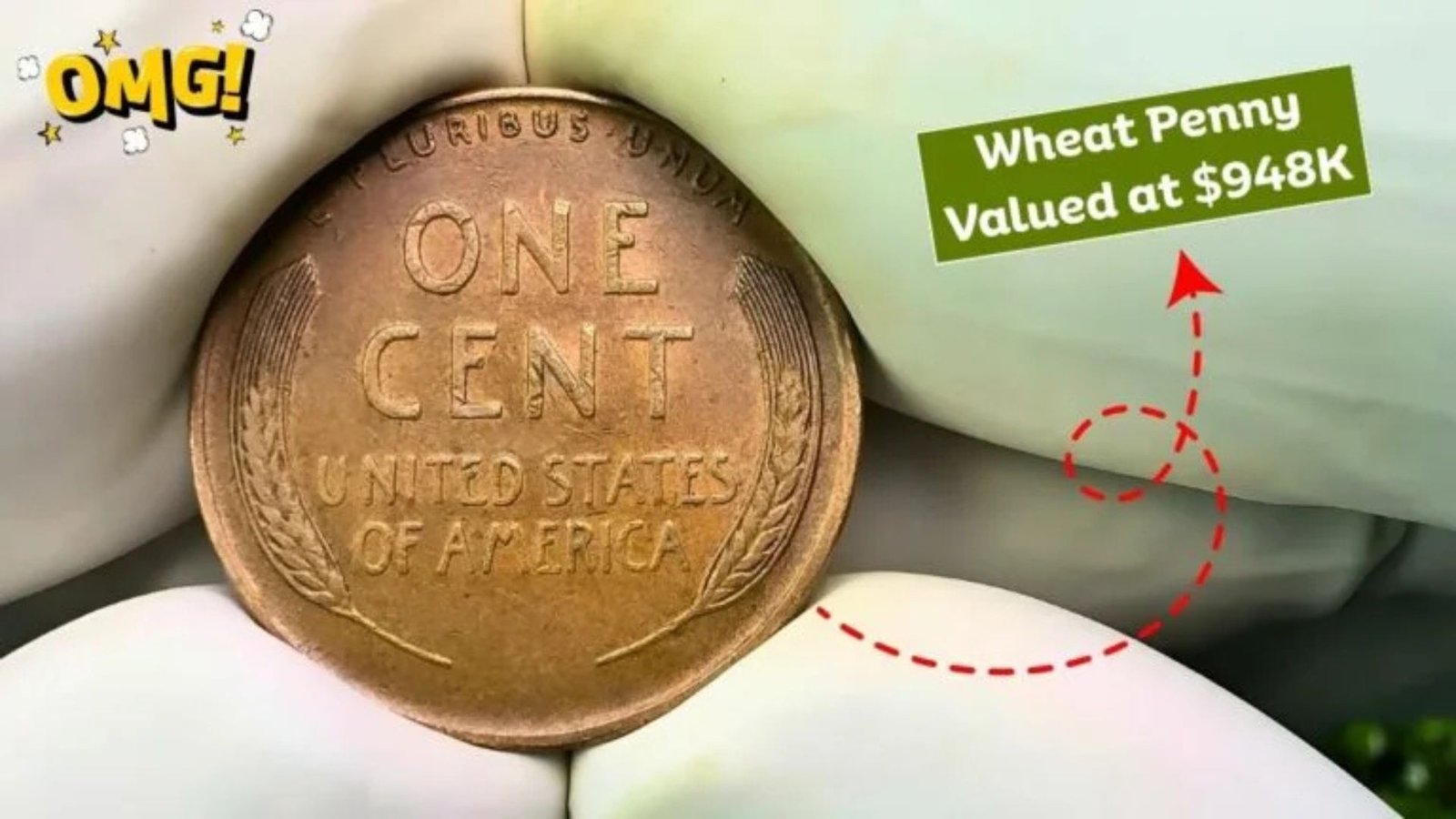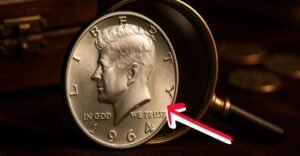Have you ever checked your loose change for a hidden treasure? The Lincoln Wheat Penny, a small coin with a big history, could be worth nearly a million dollars! Some of these rare pennies are still floating around in circulation, waiting to be discovered. we’ll dive into what makes the Lincoln Wheat Penny so special, why certain ones are so valuable, and how you can spot one. Let’s explore this fascinating piece of American history and learn how to find a coin that could change your life!
What Is the Lincoln Wheat Penny?
The Lincoln Wheat Penny is a one-cent coin produced by the United States Mint from 1909 to 1958. It gets its name from the image of President Abraham Lincoln on the front (obverse) and two wheat stalks on the back (reverse). Designed by Victor David Brenner, this coin was the first to feature a U.S. president. While most of these pennies are worth just a penny, some rare versions can fetch prices as high as $948,000 at auctions due to their scarcity and unique features.
A Brief History of the Lincoln Wheat Penny
The Lincoln Wheat Penny was introduced in 1909 to celebrate the 100th anniversary of Abraham Lincoln’s birth. It replaced the Indian Head Penny and quickly became a beloved part of American currency. Over the years, the U.S. Mint made small changes to the design and production, which created some rare versions that collectors now prize. By 1959, the wheat stalk design was replaced with the Lincoln Memorial, marking the end of the Wheat Penny era.
Why Are Some Lincoln Wheat Pennies So Valuable?
Not all Lincoln Wheat Pennies are worth a fortune, but specific years, mint marks, and errors make certain coins extremely rare and valuable. Here’s why some of these pennies are worth more than their weight in gold:
Key Factors That Increase Value
- Minting Errors: Mistakes during production, like double stamping or missing letters, can make a penny unique.
- Low Production Years: Some years had fewer pennies minted, making them harder to find.
- Mint Marks: Pennies from certain mints, like Denver (D) or San Francisco (S), can be rarer.
- Condition: Coins in excellent condition, with little wear, are worth more.
- Historical Significance: Special editions, like those from 1909, carry extra value due to their place in history.
Most Valuable Lincoln Wheat Pennies
Here’s a table of some of the rarest and most valuable Lincoln Wheat Pennies that collectors seek:
| Year | Mint Mark | Error/Feature | Estimated Value | Why It’s Valuable |
|---|---|---|---|---|
| 1909-S | S | V.D.B. Initials | Up to $948,000 | Low mintage, designer’s initials on reverse |
| 1943 | None/S/D | Bronze Error | Up to $840,000 | Rare bronze instead of steel due to wartime production |
| 1955 | None | Doubled Die | Up to $125,000 | Distinct double-stamped image |
| 1922 | None | No D Mint Mark | Up to $20,000 | Missing “D” mint mark error |
| 1914-D | D | Low Mintage | Up to $150,000 | Very few minted in Denver |
How to Spot a Valuable Lincoln Wheat Penny
Finding a rare Lincoln Wheat Penny in your pocket change is like finding a needle in a haystack, but it’s possible! Here’s how you can identify one:
Step-by-Step Guide to Checking Your Pennies
- Look at the Date: Check the year on the front of the penny. Focus on key years like 1909, 1914, 1922, 1943, or 1955.
- Check the Mint Mark: Look for a small letter (S, D, or none) below the date. This shows where the coin was made (San Francisco, Denver, or Philadelphia).
- Examine for Errors: Use a magnifying glass to spot double stamping, missing letters, or unusual materials (like bronze for 1943 pennies).
- Assess Condition: Coins with clear details and minimal scratches are more valuable. Avoid cleaning them, as this can lower their value.
- Compare with Known Rarities: Use a coin guide or online resources to match your penny with known valuable versions.
Tools You’ll Need
- Magnifying Glass: To inspect small details like mint marks or errors.
- Coin Guidebook: A reference book like the “Red Book” for U.S. coin values.
- Good Lighting: Helps you see fine details clearly.
- Coin Holder: Protects valuable pennies from damage.
Where to Find Lincoln Wheat Pennies
You don’t need to dig through ancient vaults to find a Lincoln Wheat Penny. These coins can still turn up in everyday places:
- Pocket Change: Check coins from cash transactions or your piggy bank.
- Coin Rolls: Banks sell rolls of pennies that might contain older coins.
- Flea Markets or Garage Sales: Old coin collections sometimes surface here.
- Inherited Collections: Family heirlooms might include rare pennies.
- Coin Shops: Dealers often have Wheat Pennies for sale or trade.
How to Sell a Valuable Lincoln Wheat Penny
If you think you’ve found a rare Lincoln Wheat Penny, here’s what to do next:
- Get It Appraised: Take your coin to a professional coin dealer or grading service like PCGS or NGC.
- Avoid Cleaning: Cleaning a coin can reduce its value significantly.
- Research Market Value: Check recent auction prices for similar coins.
- Choose a Selling Method: Options include auctions, coin dealers, or online platforms like eBay.
- Store Safely: Keep the coin in a protective holder to maintain its condition.
Fun Facts About the Lincoln Wheat Penny
- The 1909-S V.D.B. penny is one of the rarest because only 484,000 were made with the designer’s initials.
- During World War II, most 1943 pennies were made of steel to save copper, but a few bronze ones slipped through, making them incredibly valuable.
- The doubled die error on the 1955 penny creates a noticeable shadow effect on the date and lettering.
- Some collectors spend their lives searching for these rare pennies, known as “Wheaties” in the coin world.
Why Collectors Love the Lincoln Wheat Penny
The Lincoln Wheat Penny isn’t just about money—it’s a piece of history. Each coin tells a story of its time, from the early 20th century to the post-war era. Collectors are drawn to the challenge of finding rare versions and the thrill of owning a coin worth hundreds of thousands. Plus, the simple design, with Lincoln’s portrait and the wheat stalks, is a nostalgic reminder of America’s past.
Tips for New Collectors
- Start Small: Begin with common Wheat Pennies to learn about coin collecting.
- Join a Community: Online forums or local coin clubs can offer advice and resources.
- Stay Patient: Finding a rare penny takes time and persistence.
- Learn Grading: Understand terms like “Mint State” or “Good” to assess coin condition.
Could You Have a Million-Dollar Penny?
The idea that a single Lincoln Wheat Penny in your pocket could be worth $948,000 is exciting! While the odds are slim, it’s worth taking a moment to check your change. With a little knowledge and a sharp eye, you could uncover a hidden gem. Start by looking at the date, mint mark, and condition of your pennies, and compare them to the rare ones listed above. Who knows? Your next handful of change could hold a fortune!
Final Thoughts
The Lincoln Wheat Penny is more than just a coin—it’s a treasure hunt waiting to happen. By learning about its history, key features, and rare versions, you can join the ranks of collectors searching for these valuable pieces. Keep your eyes peeled, and you might just find a penny that’s worth a whole lot more than one cent!




